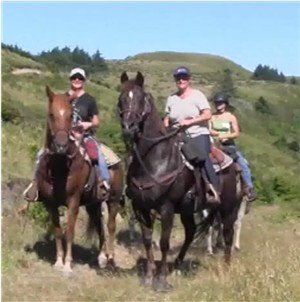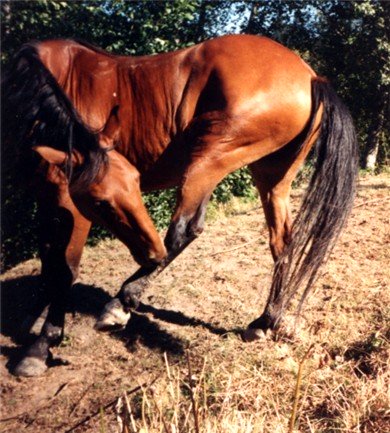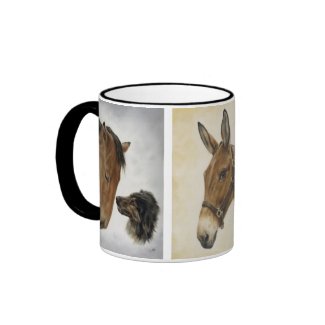Horse Wound Care Step by Step
A Guide for Successful Healing
If there's a way to get hurt, a horse will find it. These horse wound care guidelines will help you evaluate, treat and manage your horse's wound until it heals.
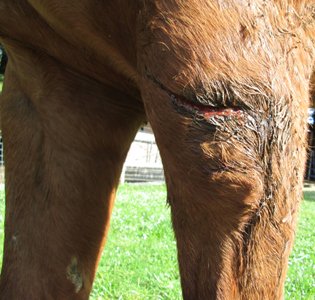 Evaluate the damage
Evaluate the damageEvaluate the Damage
Upon discovery of the wound you must first determine the severity of the injury. If the wound is superficial you can likely dress and care for it without the aid of a veterinarian.
When to call the vet:
- Deep laceration
- Damaged joint
- Damaged muscle, ligament
- Exposed bone
- Profuse bleeding
- Infection
- The wound needs stitches
- Very dirty contaminated wound
- Development of proud flesh
- Horse is in pain, shock or depressed

Horse Wound Care: Step 1
Emergency
Contact your vet if the bleeding does not stop in 10 minutes.
Too much blood loss will cause a horse to go into shock. If you suspect your horse is going into shock, blanket them and get them under veterinary care immediately.
Stop the bleeding.
To stop bleeding apply pressure to the wound with a clean lint free cloth or bandaging material. Clean paper towels, sanitary napkins and diapers work well for this.
It may take several minutes of steady pressure to get the bleeding stopped. Some wounds involve very little bleeding, allowing you to skip this step. Once the bleeding is under control you can move on to Step 2.

Horse Wound Care: Step 2
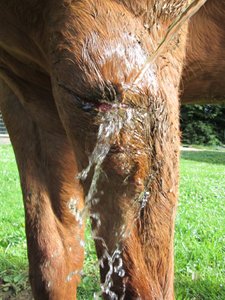 Flush the wound with water
Flush the wound with waterClean the wound.
Cool tap water straight from the hose is ideal for this. Not only does the water flush away dirt, it also reduces swelling and pain.
At this point you will be able to determine if the wound needs stitches or not. If you are unsure, call your vet.
Flush the wound and immediate surrounding area for a full 10-15 minutes with cool tap water. Avoid spraying the water with any pressure into the wound. This will only drive bacteria further into the tissue. Allow the water stream to run gently over the wound to flush away debris.
While flushing, you will have the opportunity to get a good look at the injury. If there are large pieces if debris, remove them with tweezers. If you have clippers, and your horse is cooperative, trim the hair away from the edges of the wound.
To Stitch or Not to Stitch?
Yes:
- Clean laceration
- Fresh cut less than 6 hours old
No:
- Puncture
- Wound more than 6-12 hours old
- Very contaminated wound
- Mangled wound
- Infection or swelling present
You may find skin tissue that is so damaged that it will likely slough off and die. Dead tissue that is not removed will delay healing and promote infection. If in doubt consult your vet.
After the wound had been flushed and debrided (objects, dirt and dead skin removed) it is time to clean it with an antibacterial wash.
Do not scrub a wound! Care must be taken while cleaning the wound so as not to restart bleeding or cause more damage to the injured tissues. Flush the wound with a commercially prepared Betadine Solution (Providone-iodine 5%)
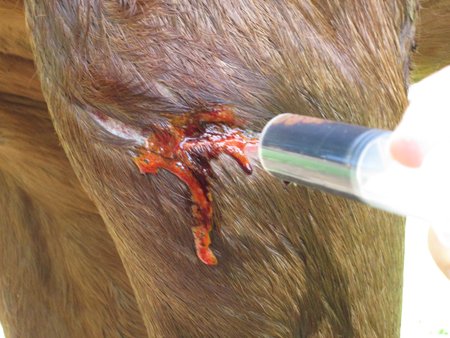 Cleaning the wound with betadine solution
Cleaning the wound with betadine solutionIf you have no Betadine or iodine solution, use a mild soap like Phisoderm or Ivory. Mix the soap with water to create a wash that you can use to flush the wound. The wound cleaner can be applied with a spray bottle, large syringe or bulb syringe. If you use soap, use liberal amounts of fresh tap water to rinse the soap away. Betadine solution need not be rinsed off.
Allow the wound to dry. Once clean and dry move to Step 3

Horse Wound Care : Step 3
Prevent infection.
The key to successful horse wound care is to prevent infection and promote healing. This can be done with antibacterial wound dressings, bandaging and antibiotics when necessary.
The type of wound dressing used will be determined by the type and location of the wound and whether or not the wound will be bandaged.
Wounds of the legs and hooves will almost always need bandaging in the beginning. These types of wounds do well with ointment style dressings.
The idea is to keep the wound clean, bacteria free (as much as possible) and free from flies.
For a leg wound, apply a liberal amount of antibacterial ointment on to a gauze pad and apply directly to the wound. (do not use cotton balls, they release too much lint) Thin sanitary napkins work well for sterile dressings. If you have no gauze or pads available, a clean sheet of paper towel cut to size and folded over will do in a pinch.
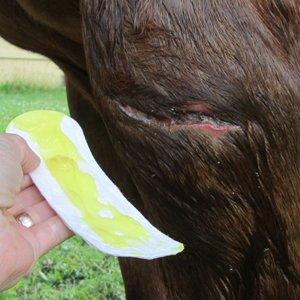 Apply a wound dressing
Apply a wound dressing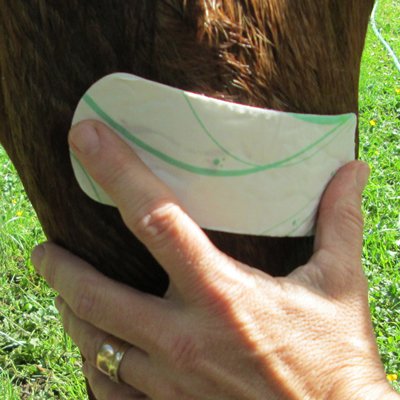 Sanitary napkins make good bandages
Sanitary napkins make good bandages|
Good ointments to use:
|
Note: Vet wrap will not stay in place on the upper leg as shown (for illustration purposes). Instead, for hard to wrap areas like this, use Elastikon Bandage Tape. Elasticon has an adhesive that will adhere to the horse hair to keep the bandage from slipping down.
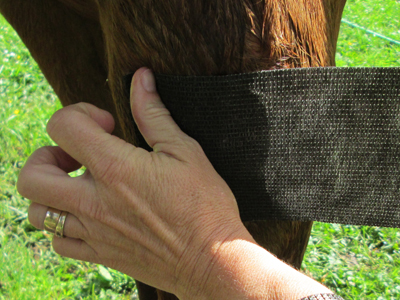
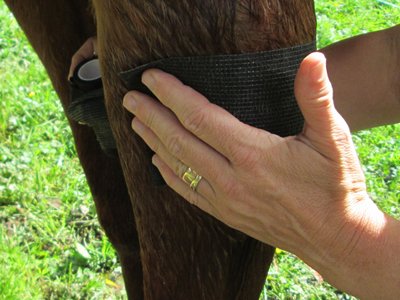
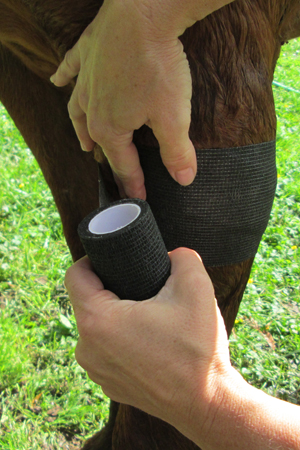
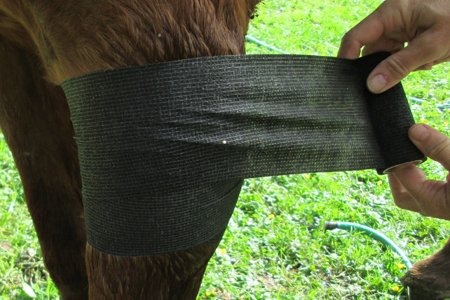
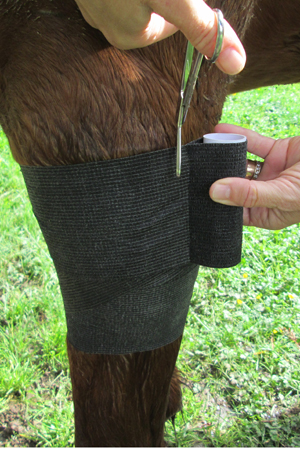
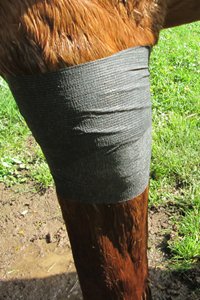
Use a bandage wrap to hold the gauze in place and wrap the injured area. Cuts on the foot and hoof area can be treated the same way. Wrap the hoof and then apply a cover of duct tape (confine duct tape to hoof only) If you have a hoof boot, use it to help keep the wound clean and dry.
Slipping Bandage? Try Elastikon Bandage Tape or Consider a Spray On
The antibacterial spray on bandage AluSpray is shown here.
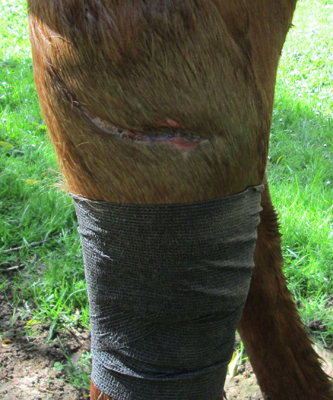 This bandage has slipped
This bandage has slipped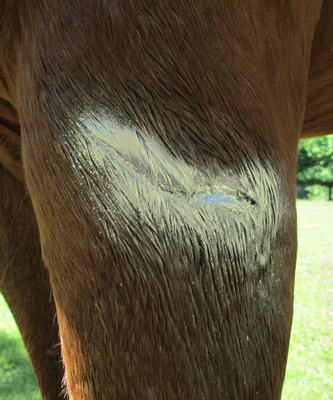 Consider a spray on bandage
Consider a spray on bandageBandaging Tip: Cut, don't tear, the end of the bandage tape or vet wrap off the roll. Pulling on the vet wrap to tear it off can tighten it too tight, cutting off circulation to the leg.
Duct Tape Tip: Duct tape can be used over vet wrap to keep bandaging dry in harsh conditions. Use caution that you do not wrap too tight! Use bandage scissors to remove.
For wound areas that are difficult or impossible to bandage, they will have to be left unwrapped. To protect this type of wound you can use several types of wound dressing
- Ointment
- Spray on
- Powder
My favorite dressing for horse wound care is Nitrofurazone Ointment. Swat Clear Formula wound ointment, put out by Farnum, is also a nice choice of ointments for wounds needing fly protection. It can be applied liberally directly to the wound and it repels flies as well.
This combo fly repellent/wound ointment is specifically designed for use on open wounds and sores. Don't confuse it with other non-wound Swat fly repellent products. If in doubt read the label carefully for application instructions.
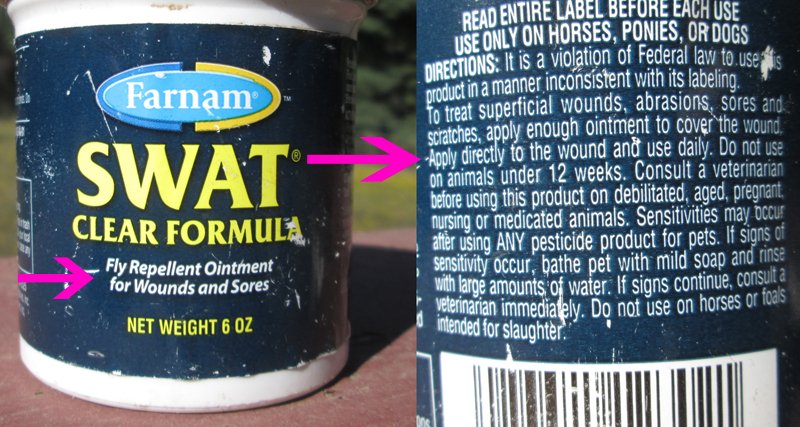 Do NOT confuse this wound ointment with other Swat fly repellent products - Read the Label
Do NOT confuse this wound ointment with other Swat fly repellent products - Read the LabelVetericyn is a liquid spray on wound dressing that kills bacteria and promotes healing. Scarlet red is also a good wound dressing that comes in an aerosol can called Red-Kote. AluSpray, put out by Neogen Vet, is an aluminum based aerosol bandage. It acts as a barrier and retards bacterial growth.
Wonder Dust is a powder wound dressing used to stop bleeding and discourage proud flesh. It is best used with abrasion type wounds and on wounds that have healed to the point they can go un-bandaged.
Most wounds will heal faster with moist dressings in the initial days. Dry dressings are more helpful with very superficial wounds.

Horse Wound Care: Step 4
Wound Maintenance
Once you have successfully cleaned and wrapped the wound you will want to change the bandage at least twice a day.
The first few days, it's a good idea to hose the wound off with cool water for 10-15 minutes with each bandage change. This will help keep swelling down, promote cleanliness and provide pain relief.
Allow the wound to dry, then apply a fresh round of wound dressing, clean bandages and vet wrap. Your horse wound care job will be much easier and your will be horse safer, if you invest in a pair of bandage scissors for removing bandages.
Spray on wound dressings for un-bandaged wounds often call for 3-4 applications per day until the wound is healed. Follow the instructions on the bottle.
Many wounds will be ready to go un-bandaged in 5-10 days. You will still need to keep an eye on the wound, apply dressings and monitor the healing process. If your horse re-opens the wound, clean it and apply a fresh bandage. Monitor for signs of infection.
After 10 days this wound was allowed to form a scab, treated intermittently with a spray on horse wound care dressing and monitored as is healed.
Horse Wound Care - Red Flag Warnings
The more severe the wound the higher the odds of infection. You will need to watch out for signs of infection, in which case you must consult your vet.
Proud Flesh
At 10 days wound shows a healthy, normal layer of proud flesh, laying the foundation for new skin growth. Cottage cheese like proud flesh would be cause for concern.
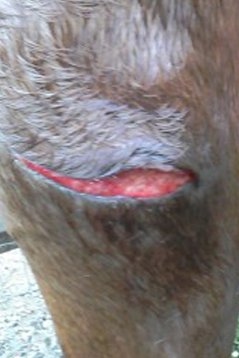 An acceptable amount of proud flesh (yellowish/pink in color)
An acceptable amount of proud flesh (yellowish/pink in color)Signs of trouble:
- Persistent swelling
- Heat
- Pus
- Wound edges separate and dry out
- Stitches pulling apart
- Stitches buried into swollen tissue
- Foul smell
- Bubbling under the skin
- Fever
- Depression
- Excessive proud flesh
A Note about proud flesh:
Proud flesh is a pink cottage cheese like flesh that grows over an open wound. It forms a natural barrier and lays the foundation for new skin growth as a normal part of the healing process.
Proud flesh becomes troublesome when it grows profusely. Left unchecked it can become an unsightly mass of flesh that bleeds and weeps.
To discourage the growth of proud flesh, keep the wound slathered in antibacterial wound dressings under the protection of bandages until the skin can grow back.
When the wound is ready to go un-bandaged, apply Wonder Dust to dry and discourage proud flesh. If at any point in the wound healing process you feel proud flesh is growing too much, call your vet.
Antibiotics and Tetanus Shots
Wound at Day 30
At day 30 the wound is all but healed. This horse did receive a Tetanus shot for this particular cut, as it was deep and dirty.
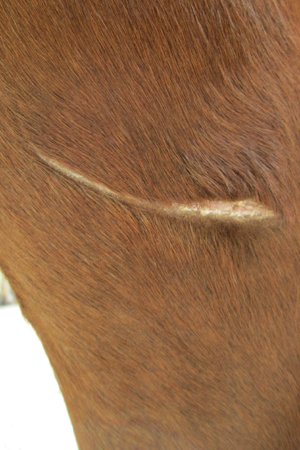 Wound after 30 days
Wound after 30 daysIf the wound is deep, in a joint, very dirty with contamination, complicated, infected or discovered late (many hours old) your vet will likely administer antibiotics.
Depending on the severity, they may also give a pain medication like, Phenylbutazone aka bute.
It is a very good idea to give your horse a Tetanus booster shot, especially with deeper wounds.
The Tetanus bacteria is found in soil. Did you know that many horses carry the Tetanus bacteria in their gut? It is only when tetanus enters torn flesh that the horse is at risk for deadly lock jaw. This is one more reason to practice good horse wound care; keeping wounds clean and free of contaminants, soil and manure.
Horse wound care is a skill that every horsemen should learn. Sooner of later you're horse is going to need it.
If you haven't already done so, I highly recommend putting together a horse first aid kit and purchasing a good equine emergency care manual.
A good emergency manual, like the one below, will walk you through the steps you need to take in a variety of situations from wrapping joints to treating burns until you are able to seek veterinary care.
More Equine Topics You May Enjoy
Horse First Aid Kit
Find out what items you need to build a well rounded horse first aid kit for your barn, your truck and on the trail.

